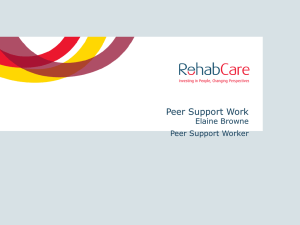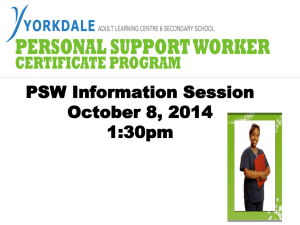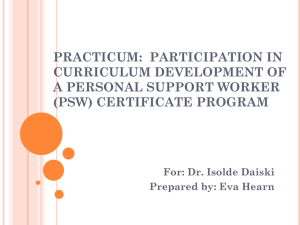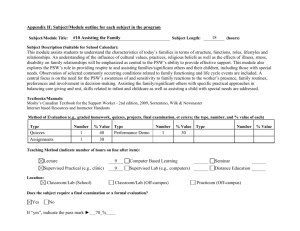Key situations in social work as a bridge between theory and practice
advertisement
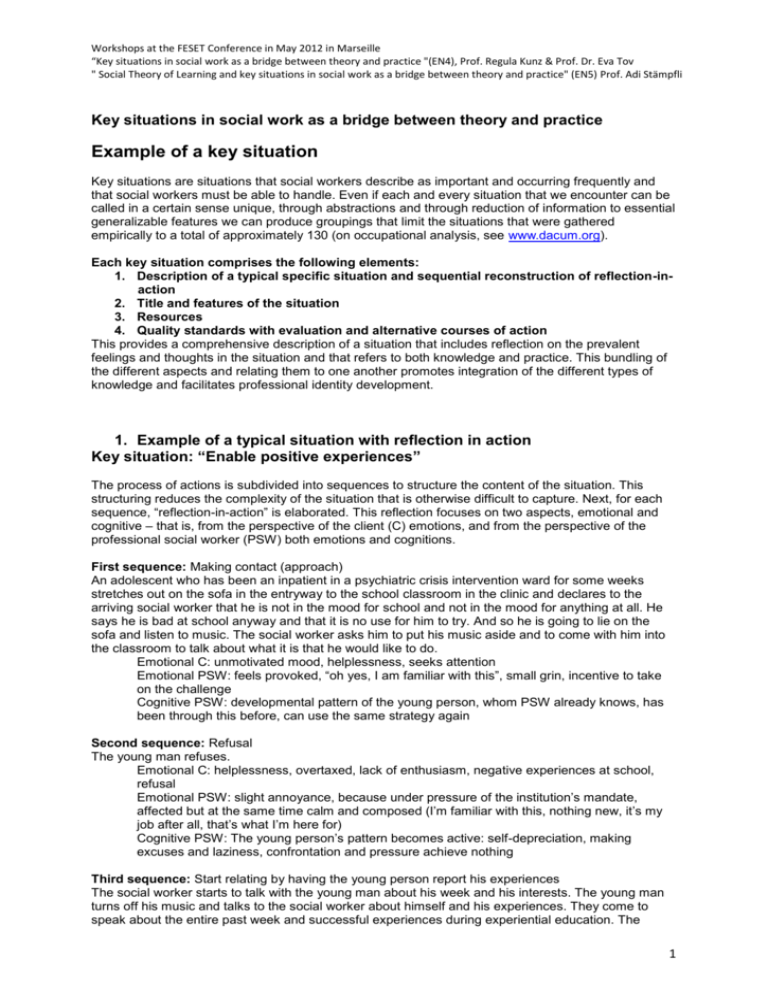
Workshops at the FESET Conference in May 2012 in Marseille “Key situations in social work as a bridge between theory and practice "(EN4), Prof. Regula Kunz & Prof. Dr. Eva Tov " Social Theory of Learning and key situations in social work as a bridge between theory and practice" (EN5) Prof. Adi Stämpfli Key situations in social work as a bridge between theory and practice Example of a key situation Key situations are situations that social workers describe as important and occurring frequently and that social workers must be able to handle. Even if each and every situation that we encounter can be called in a certain sense unique, through abstractions and through reduction of information to essential generalizable features we can produce groupings that limit the situations that were gathered empirically to a total of approximately 130 (on occupational analysis, see www.dacum.org). Each key situation comprises the following elements: 1. Description of a typical specific situation and sequential reconstruction of reflection-inaction 2. Title and features of the situation 3. Resources 4. Quality standards with evaluation and alternative courses of action This provides a comprehensive description of a situation that includes reflection on the prevalent feelings and thoughts in the situation and that refers to both knowledge and practice. This bundling of the different aspects and relating them to one another promotes integration of the different types of knowledge and facilitates professional identity development. 1. Example of a typical situation with reflection in action Key situation: “Enable positive experiences” The process of actions is subdivided into sequences to structure the content of the situation. This structuring reduces the complexity of the situation that is otherwise difficult to capture. Next, for each sequence, “reflection-in-action” is elaborated. This reflection focuses on two aspects, emotional and cognitive – that is, from the perspective of the client (C) emotions, and from the perspective of the professional social worker (PSW) both emotions and cognitions. First sequence: Making contact (approach) An adolescent who has been an inpatient in a psychiatric crisis intervention ward for some weeks stretches out on the sofa in the entryway to the school classroom in the clinic and declares to the arriving social worker that he is not in the mood for school and not in the mood for anything at all. He says he is bad at school anyway and that it is no use for him to try. And so he is going to lie on the sofa and listen to music. The social worker asks him to put his music aside and to come with him into the classroom to talk about what it is that he would like to do. Emotional C: unmotivated mood, helplessness, seeks attention Emotional PSW: feels provoked, “oh yes, I am familiar with this”, small grin, incentive to take on the challenge Cognitive PSW: developmental pattern of the young person, whom PSW already knows, has been through this before, can use the same strategy again Second sequence: Refusal The young man refuses. Emotional C: helplessness, overtaxed, lack of enthusiasm, negative experiences at school, refusal Emotional PSW: slight annoyance, because under pressure of the institution’s mandate, affected but at the same time calm and composed (I’m familiar with this, nothing new, it’s my job after all, that’s what I’m here for) Cognitive PSW: The young person’s pattern becomes active: self-depreciation, making excuses and laziness, confrontation and pressure achieve nothing Third sequence: Start relating by having the young person report his experiences The social worker starts to talk with the young man about his week and his interests. The young man turns off his music and talks to the social worker about himself and his experiences. They come to speak about the entire past week and successful experiences during experiential education. The 1 Workshops at the FESET Conference in May 2012 in Marseille “Key situations in social work as a bridge between theory and practice "(EN4), Prof. Regula Kunz & Prof. Dr. Eva Tov " Social Theory of Learning and key situations in social work as a bridge between theory and practice" (EN5) Prof. Adi Stämpfli social worker reminds the young man of his learning objectives, which he himself has set. He also reminds the young man that school is compulsory and that it is not for him to choose whether to attend or not. Then they speak together for quite a while about the young man’s music interests. Here the young man is very receptive/attentive and open. Emotional C: under pressure, unmotivated, satisfied with and happy about the attention he is receiving Emotional PSW: helplessness, impatience, tension between necessity for school and the young person’s current need, interest in the young person Cognitive PSW: PSW devotes attention to the relationship level and to the C, focuses deliberately on the young man’s successful experiences, creates a connection via shared experiences, reminds the young person of the goals he has set himself to appeal to his own motivation. Makes the young person aware that school is compulsory and what the consequences are if he does not attend. Once again distraction, avoidance of the topic of school to go back to the young man’s interests in order to maintain contact, and then gives him the clear message that he should go into the classroom. Fourth sequence: Deliberate ending of the encounter After a while, the social worker again asks the young man to accompany him into the classroom. The young man does not want to and says so. The social worker explains to him that he would like to work with him in the classroom. But now he has to take care of the other children and young people, too, and so the young man will find him in the classroom. Emotional C: does not feel taken seriously, defiance, disappointment Emotional PSW: impatience, annoyance/anger, proud that he was able to keep distance Cognitive PSW: do not give the young man any more attention for as long as he does not participate in schoolwork. Distance myself and communicate clear message: we are at school, and it’s time to work! Fifth Sequence: Reestablish contact and conclude the situation successfully After a while, as the young man still does not take his place in the classroom, the social worker brings him a puzzle game and shows it to him. The young man shows interest and now takes his place in the classroom. He begins to work on the puzzle. After a few tries, he finds the solution and is happy about his success; he shows the social worker his results. The social worker praises him. The young man solves a few more puzzles until he manages to find some interest in working on French, which is one of the learning goals that he has set for himself. Emotional C: interest, curiosity, proud about meeting learning objectives (putting the music away, taking his place in the classroom, concentrating on French), happiness, feeling of success Emotional PSW: pride, happiness, relief that the young man gets on track and experiences success Cognitive PSW: find new ways to approach the young man and to engage his interest. Give him something that helps him to concentrate and to experience success. Deliberately take his mind off lessons and first develop and strengthen his school readiness (to take his place in the classroom and focus on working). Give positive reinforcement for his first successes. 2. Title and features of the situation The features define all situations that in professional action can come under the title “Enable positive experiences.” They thus generalize the typical example, which can also take place in other institutional contexts with other clients. The features of the key situation “Enable positive experiences” are the following: • The client does not believe that he or she can achieve something (lack of self-efficacy) • The client has had negative experiences • The clients is afraid to take part in a situation • The professional social worker makes it possible for the client to gain trust in the professional relationship and in his or her own abilities, by ensuring, in small steps, that the client experiences success both at the relationship level and at the level of problem solving. This encourages the client to continue to cooperate. 2 Workshops at the FESET Conference in May 2012 in Marseille “Key situations in social work as a bridge between theory and practice "(EN4), Prof. Regula Kunz & Prof. Dr. Eva Tov " Social Theory of Learning and key situations in social work as a bridge between theory and practice" (EN5) Prof. Adi Stämpfli 3. Resources For professional social work practice in a situation, knowledge and techniques are required, and abilities/skills and prerequisites are utilized; in this model these are all called “resources.” The following resources are distinguished: • Theoretical (scientific) knowledge • Intervention knowledge • Experiential knowledge • Organization and context knowledge • Skills • Organizational, infrastructural, temporal, and material prerequisites • Values knowledge In the following, for each category at least one resource is described based on the professional discourse in social work: Theoretical (scientific) knowledge Motivation theory (Euler & Hahn, 2004): The basic model of motivation says that a motive is a person-specific disposition mediating between person and situation. According to Atkinson (cited in Euler & Hahn, 2004), achievement motivation is made up of intrinsic motivation (hope for success, fear of failure) and extrinsic motivation (reward/force). A basic distinction can be made between failure-oriented and success-oriented students. Intervention knowledge Motivational interviewing (Miller & Rollnick, 1999) is based on insights on the change process described by Prochaska and DiClemente (1982) and is a person-centered, non-confrontational method in the humanistic tradition. The four fundamental principles of motivational interviewing are: (1) express empathy through active listening, (2) create discrepancy (open questions help the client to find reasons for change), (3) roll with resistance and ambivalence in the change process, and (4) support self-efficacy. Experiential knowledge Experiences with the client in past situations. Example: Give him attention (talk about freetime), then distance yourself again (“if you would like attention, then come into the classroom”) and then give attention again for (school) actions (puzzle game work). This has often worked in the past. In similar situations with other clients, you found that exerting pressure did not achieve anything except increase the client’s opposition. The experience that maintaining the relationship is more important than having the client appear in the classroom on time. Organization and context knowledge The organization is commissioned to promote social, school, and psychological development. All three aspects of the support can be weighted differently depending on the situation. Intensive interdisciplinary cooperation with other professional fields (psychotherapy, social pedagogy) is necessary. Skills Being able to talk to the client using the principles of motivational interviewing. Specifically, this means expressing empathy and understanding the client’s situation, raising open questions to get the client to name his personal goals, dealing flexibly with opposition, and promoting self-efficacy through making (small) positive experiences possible. Organizational, infrastructural, temporal, and material prerequisites Individual mentoring is possible in the school context. But there is limited time available for individual attention outside the classroom door, as presence in the classroom is required. 3 Workshops at the FESET Conference in May 2012 in Marseille “Key situations in social work as a bridge between theory and practice "(EN4), Prof. Regula Kunz & Prof. Dr. Eva Tov " Social Theory of Learning and key situations in social work as a bridge between theory and practice" (EN5) Prof. Adi Stämpfli Values knowledge Professional code of conduct, professional ethics: Safeguard the young person’s right to selfdetermination Mission of the organization: Relationship to the young person takes priority over material or practical constraints Conception of human beings: There is good in every person (humanistic conception of human beings); this should be found in every situation. 4. Quality standards with evaluation and alternative courses of action Professionalism demands that situations are handled in accordance with certain quality standards. The resources described above support achievement of the required quality. The standards are formulated in a way that they are not so general that they depict general standards of the profession but instead in a way that does justice to the demands of the particular key situation specifically and in a differentiated manner. Quality standards for the key situation “Enable positive experiences”: The client’s self-efficacy is strengthened. The client’s fear of failure is reduced. The emotions of the professional in interaction with the client are controlled, and the necessary role distance was maintained. The client was reminded of his own abilities and strengths (good experiences of the past week, his own personal learning goals), and they were mobilized for handling the situation (self-efficacy was increased). On the basis of these quality standards, the described situation can be reflected upon and evaluated. This might look like this, for example: The young man in this situation is oriented towards failure (motivation theory). He himself does not believe in the possibility of success owing to his own achievement (low self-efficacy). For this reason, the intervention following a Behaviorist approach (reward = attention when desired behavior exhibited, while at the same time ignoring undesired behavior) is likely to be useful for his intrinsic motivation. His extrinsic motivation is promoted by the PSW’s clear communication. At the same time, with the puzzle game, a small success is made possible (positive experience), which helps the further course along. Role distance: The professional was not able to completely fulfill role distance, because he did not have a clear understanding of the reason for his annoyance/anger (double mandate; the reason for his anger was the institutional pressure to make this young man ready for school – not the situation itself). Handling refusals to attend school are after all part of his daily work; the young man would not be in the institution otherwise. The social worker could take the young man’s school refusal in a calm and composed way, as a professional challenge and not as a disturbance. This he succeeds at more and more throughout the course of the situation. 4
